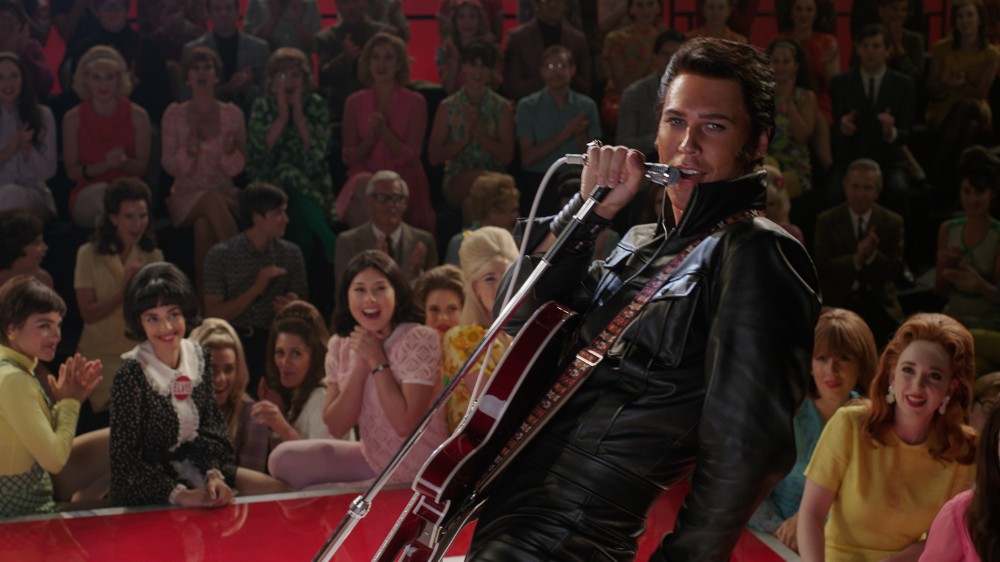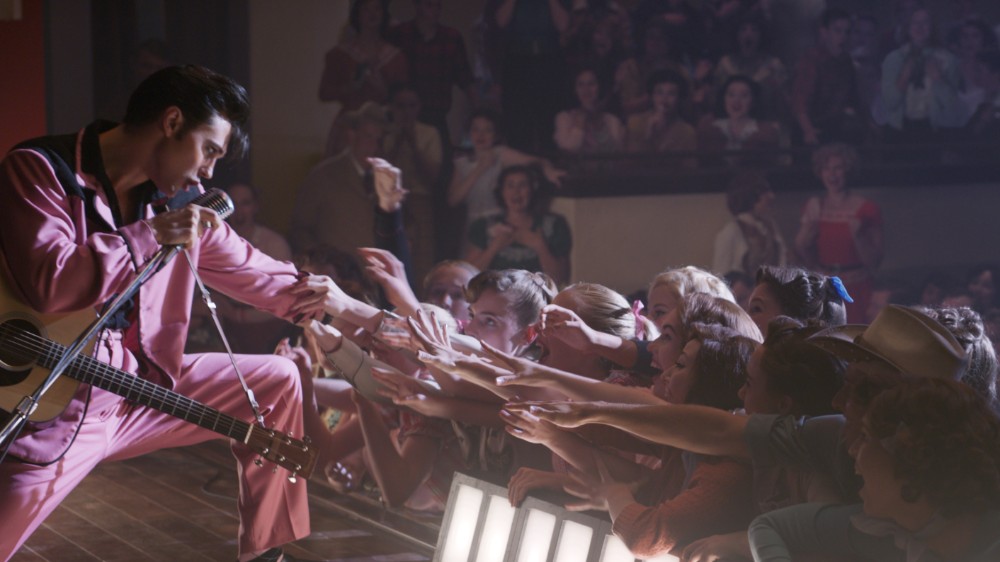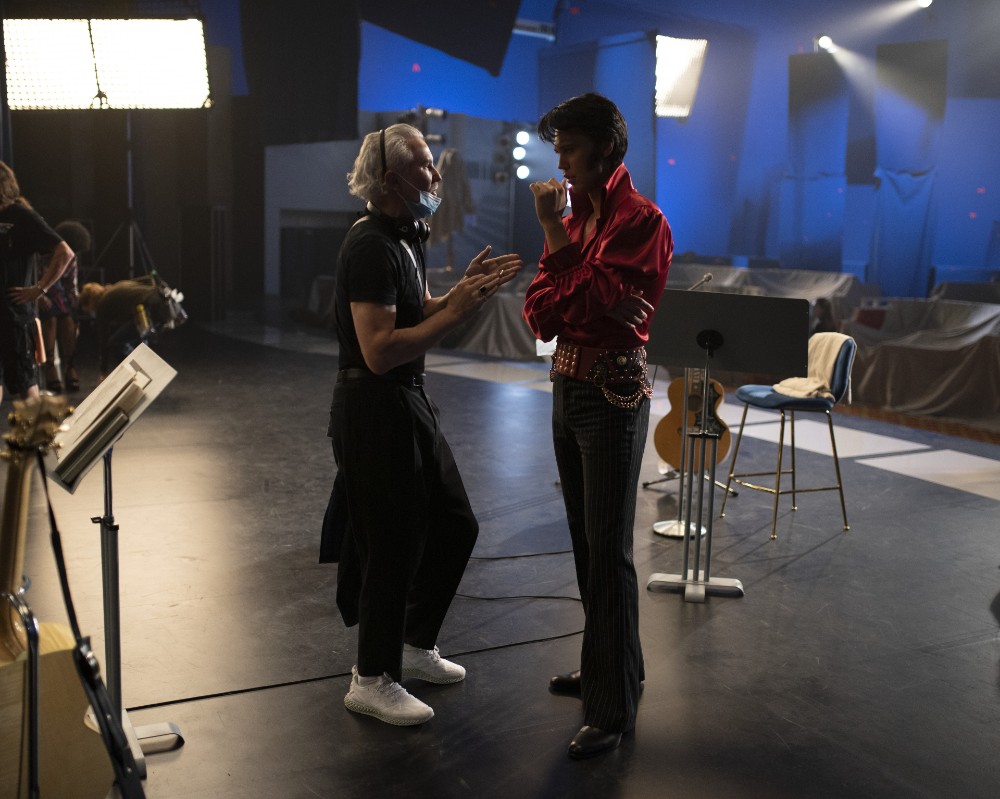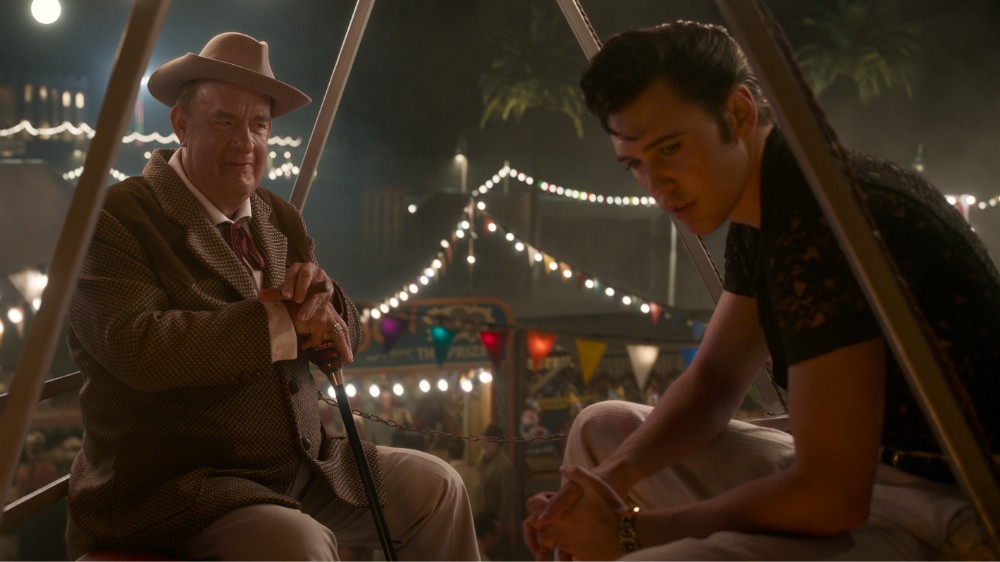
Catherine Martin is just an incredible craftsperson, an amazing woman who has won four Oscars for her work with her husband, director Baz Luhrmann — two each for her costumes and production design for Moulin Rouge! in 2001 and The Great Gatsby in 2013. She has been Luhrmann’s production designer going back to Strictly Ballroom in 1992, and she has designed the costumes for all of his films with the exception of Romeo+Juliet, and at the same time, she has worked her way up the production ladder to become a full producer on both Gatsby and Luhrmann’s latest effort, Elvis.
As the title might imply, the film is Luhrmann’s take on the story of rock ‘n’ roll icon Elvis Presley, as portrayed by Austin Butler (Once Upon a Time in Hollywood). It follows his rise from poverty to fame and fortune, from his days as a young performer in the South to the height of his stardom and ultimately, his demise. Tom Hanks co-stars as Colonel Tom Parker, the semi-scrupulous Dutch emigré who would become Elvis’ manager and pave the way for some of the singer’s greatest triumphs but also set the stage for his tragic downfall and premature death.
As might be expected from a Baz Luhrmann film, Elvis looks marvelous, and as always, his wife is working with him hand-in-hand to make his grand vision come to life on the big screen in a way we rarely get to experience, as Elvis is only Luhrmann’s sixth feature film in 30 years.
Below the Line had the immense pleasure of speaking with Martin by phone about many aspects of Elvis, both the movie and the rock legend himself.

Below the Line: You have a really interesting relationship with Baz, besides being his wife, obviously. You do both production design and costumes, which is not something you see that often, but you’re also a producer, so you can make sure those departments have a proper budget. Was Elvis someone he had been wanting to make a movie about for a while?
Catherine Martin: Baz has been talking about Elvis since I met him over 30 years ago, so he has had a real interest in his place in the pantheon of icons of America and how what he did intersected in kind of a momentous period in history in America. I was much more just like, ‘Oh, that’s Elvis,’ but not unmoved either way. It was when Baz started talking about his vision for this movie that wasn’t just making a biopic. It was on a much larger canvas that spoke to Elvis’s historical context. It was about the relationship between art and commerce. For good and for bad, it was about a complicated relationship between two men over a long period, so they’re the things that really interested me, his way of unfolding the story.
BTL: Did Elvis actually ever get down to Australia at all?
Martin: He never got to Australia. He only went to Europe, Germany, he went to Paris, it was just during the service, and he went to Hawaii, but that’s still in America. Basically, he never traveled, although he was offered a lot of tours from Australia, people [were] willing to pay him millions of dollars actually to come here.
BTL: This must have offered a different challenge than the other movies you’ve done with Baz because your characters are real people and you’re recreating real events. Elvis is a particularly interesting case because he was breaking out just as television was coming of age. I assume there were a lot of television appearances you could use for reference?
Martin: I think the incredible thing about Elvis was that his fame was a product of TV because TV was like the social media of the day. It was very deliberately sought out by Colonel Tom Parker, because of its incredible audience reach. I think the combination of radio airplay and television really catapulted Elvis to fame. In terms of the costume, Elvis was an incredible stylist of his own look. His changing look is really a product of his evolution as a person and as a performer. It is incredible how each moment of his life is so defined by what he wore. I asked myself how much of what he wore was as a reaction to his own kind of innate shyness and sensitivity. I mean, Elvis had stage fright throughout his life, so I think as a performer, he was constantly creating a persona on and off the stage. That’s what makes it so interesting, because I think costumes allow you a window into social history and psychology. Certainly, that was something that all the research that we did, and the countless photos we examined did for us, they allowed us a little window into Elvis’s psychology and humanity.

BTL: Oddly, I just watched a documentary about Marc Bolan of T. Rex, and it’s amazing what color television did for them as a band (and for glam rock) since they were wearing these suitably colorful outfits just as color television became a thing. Since Elvis first appeared in black and white, how did you figure out what colors his costumes were supposed to be? I assume many of them are still in museums somewhere?
Martin: Some are still around, so you can reference them in the archives at Graceland, and then others, we made judicious choices that [leaned] into how we wanted things to look on screen. So for instance, when Elvis appears on [The] Milton Berle [Show], we know that his shirt was black and pink because it still exists. We chose to lean into his jacket being pink and the same window-pane check and everything as it was on Milton Berle because it completed the look in a way that we liked. Elvis famously liked black and pink, so it wasn’t a stretch, but if you go online, there are so many colorized images of those particular photos that were taken at the time of Milton Berle. To be frank with you, I haven’t got to the bottom of exactly what color that jacket was, but we chose to make it pink because it went with his outfit.
BTL: Priscilla and Lisa Marie Presley are still alive, so did you have them as resources, even in terms of whether they still have a lot of his stage outfits?
Martin: Graceland are great custodians of Elvis’s and his family’s legacy in terms of the archive, so they have an enormous collection of clothing — everything from the leather suit from the ’68 special to I think almost the entire collection of jumpsuits. Elvis [has been] very well archived. They have every receipt that Vernon Presley assiduously kept. They have many of Gladys’ dresses. They have sunglasses and accessories and boots and shoes. It’s possible to view a large number of artifacts within the archive, which we did, and they were extremely generous, Graceland, in letting us look and work with the managing archivist, Angie [Marchese]. We were lucky to be able to use that resource, and then I was lucky enough to have lunch with Priscilla and Baz, and Jerry Schilling, which was fabulous. We talked about the Colonel and Elvis, and then, of course, COVID came, and it became more difficult to have a relationship that included consultation. As I think relatively recently has come to light, the family has been incredibly embracing [toward] the movie, and that was a monumental relief. Baz said, ‘I’ve never been more nervous about an audience screening than I have to have the Presley family, most particularly Priscilla, and of course, Lisa Marie and Riley [Keough] and all the other members of the family, watch the movie, and really embrace it.’ I mean, to say that we’re thrilled about that is an understatement.
BTL: What was the timeline of visiting Graceland and Baz writing? Are both of you doing a lot of the research and meeting the family, as you mentioned, before he even starts writing?
Martin: It’ll be a concurrent kind of process where he’ll be developing the story. He’s a very visual director, so he’ll have a perspective on how he wants things to look. He’ll scribble little sketches, he’ll give you tear sheets from magazines or images off the internet, and you’ll have a visual framework. And then, he’ll set you various research tasks, and he’ll start writing a treatment, and some of those visual research tasks feed directly into the script. It’s really important for him to understand… for example, the trajectory of the jumpsuits. We did a huge chart that basically analyzed all the jumpsuits, when they were worn, what year they were made, [and] were there any little anecdotes that surrounded them? It was all about trying to help as much as possible, [and] give him the visual storytelling cues that would help him to unfold the story.

BTL: One of my favorite parts of the movie was the montage of Elvis touring after his first Vegas residency, and you see all these different jumpsuits and outfits, many of which you only see on screen for a few seconds each.
Martin: We took all the jumpsuits that Elvis did were in his performing career, but in order to see the spiral of Elvis’s emotional state, Baz decided that what we should do — even though this isn’t necessarily chronologically correct in terms of … we’re not making a documentary, we’re trying to tell a story — was to start with the much purer white outfits, and then we start to add in color, and the outfits become crazier and crazier and crazier and crazier to kind of underline the frenetic touring schedule and his descent into not exactly madness, but disconnection from normal life, I suppose.
BTL: Elvis was completely filmed in Australia? I was trying to figure that out since the story goes to Las Vegas, and of course, Graceland.
Martin: Completely filmed [in Australia], so the Vegas showroom was built on stage, and we had a very talented visual effects team, headed up by Tom Wood, who we worked closely with to extend the showroom. But it was a very big portion of the showroom that we built. It sat about 450 extras, so you can imagine it’s quite a large set. We had most of the gold curtain working, as it did in Vegas. In fact, the gold curtain was made out of the very same fabric that the gold curtain in Vegas was made out of, because Gerriets, which is a German theatrical cloth and curtain supplier — and they’ve been around for decades — they had supplied the fabric for the original curtain, and they were able to find the sample, and then mill fabric for us to match.
BTL: It’s also amazing how you recreated these Southern towns from the ’50s and ’60s, and I assume a lot of that had to be built as well?
Martin: We built a lot of stuff, and we filmed the driving on location, and I did a reconnoiter with the art department, a couple of them actually, where we drove Elvis’ tour route, so we’d have a sense of what the Southern landscape was like. Because of course, you’re always nervous when you’re not a native of a particular area, you want to be respectful and sensitive to what it was really like.
BTL: That’s also what impressed me about The Get Down. I’m a New Yorker, but I didn’t live here in the ’70s, though I’ve seen documentaries about that time, and the series was very accurate.
Martin: I think what Baz really wants to do is always lean in to reference historical reality, [and] interview a lot of people that were there at the time, as much as possible. That’s certainly what we did on The Get Down, get to the essence of what it felt like to be there at the time. I know on The Get Down, so many of the people that actually were there in the Bronx at the time said to us, ‘Oh My God, it was exactly like that.’ I think that’s sometimes one of Baz’s great abilities is to actually understand what it felt like, and then ask us to not replicate exactly how it was. We all take photos of ourselves at nightclubs and think we look amazing, and our makeup and hair [were] perfect, and we all know that the morning after, our impressions were absolutely incorrect.

What you need to do is express how you felt in that situation, as opposed to how it really was. Certainly, with [this] movie, you’ll see some sequences, and it’s particularly telling if you watch the scene where Austin goes into the crowd in the International showroom, and he starts kissing girls in the audience. If you watch at the end, you’ll see the real Elvis doing that. The level of the blur between fiction and fact is seamless. I think that’s Baz and Austin and Tom… and I forget to talk about Tom a lot because, in my mind, he’s just become the Colonel. So I don’t even view him as Tom Hanks anymore, I just think, ‘Oh, yeah, I think of the Colonel as a real person, not as Tom Hanks.’ I’d always say to Tom, ‘Gee, you look incredible,’ and he goes, ‘Yeah, you’ve just seen [me] as a fat, really ugly old guy, and you’re just in a state of shock,’ but I think the creation of his persona is just so complete that I just think, ‘Oh, that’s Colonel Tom Parker.’ That’s who I think he actually is. I don’t think it’s a created character. I’ve just come to think that he’s kind of charming, but really bad.
BTL: It may be the closest Tom has come to playing an actual bad guy, maybe.
Martin: Yeah, he’s a bad guy with lots of charm, but I think this is just kind of part of … who knows what the secret of people’s success is, but Tom is absolutely cognizant of all of the Colonel’s flaws, but he still loves him. I think in order to be so extraordinary, you have to really identify and fall a little bit in love with the alter ego that you’re portraying.
BTL: Absolutely. I do want to get back to Austin and the costumes he’s wearing as Elvis for a second. One of the considerations for the costumes you’re creating for him is that he has to be able to perform and do all those dance moves and stuff. The evolution of the character through his costumes is critical, but he also has to perform in them, so how did you make sure that was possible?
Martin: We did a lot of rehearsal in prototypes of outfits to make sure that Austin could work in them. We made some alterations to the way the costumes worked in the past, to enable him to get his arm seamlessly above his head, and to get into a squat, and to do all of that stuff. Also, sometimes it’s necessary to have a number of different versions of a particular costume. There’s one that looks really nice when he’s got his hands by his side, and he’s just standing there. There’s one that really works for all the crazy dance moves. There’s one that you like to keep super-clean so that when we do a close-up, it’s just immaculate. It’s about having enough versions so that you can burnish each individual situation. It’s also having the time, which is one of the great things about Baz is he always is demanding of preparation, and just having access to the actor and having a rehearsal process so that you can actually put things into the rehearsal room and make sure they work, that the actor can actually rehearse in the right shoes, and in at least a prototype of the costume.
Elvis is set to shake up theaters nationwide on Friday, June 24.





